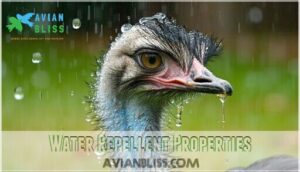This site is supported by our readers. We may earn a commission, at no cost to you, if you purchase through links.
 When you wonder why do ostriches sit in the rain, you’re witnessing a clever survival strategy. These massive birds don’t have waterproof feathers like ducks, so they can’t just shake off water and carry on.
When you wonder why do ostriches sit in the rain, you’re witnessing a clever survival strategy. These massive birds don’t have waterproof feathers like ducks, so they can’t just shake off water and carry on.
Instead, they sit to conserve energy and regulate body temperature while their feathers become waterlogged. Rain actually serves as nature’s shower for ostriches—they’ll ruffle their feathers to get clean when it’s light.
However, during heavy downpours, sitting becomes their go-to move for efficient thermoregulation. Their specialized posture helps manage heat loss while coping with soaked plumage.
The real surprise lies in their sophisticated behavioral adaptations that turn a potential disadvantage into survival gold.
Table Of Contents
- Key Takeaways
- Ostrich Behavior Explained
- Why Ostriches Sit Rain
- Ostrich Waterproof Feathers
- Ostriches in Wet Conditions
- Ostrich Rain Survival Tactics
- Frequently Asked Questions (FAQs)
- Why would a bird just sit in the rain?
- What are 5 interesting facts about ostriches?
- Where do birds go when it rains really hard?
- How long can an ostrich survive without water?
- Why do birds sit out in the rain?
- Why are birds capable of flying in the rain?
- How do birds survive heavy rain?
- What is the lifespan of an ostrich?
- What do ostriches do in the rain?
- Why are ostriches so fascinating?
- Conclusion
Key Takeaways
- You’ll see ostriches sitting in the rain because they’re conserving energy – their non-waterproof feathers become heavy when wet, so sitting prevents exhaustion while maintaining body temperature through efficient thermoregulation.
- Rain serves as nature’s shower for these birds – they’ll ruffle their feathers during light rainfall to get clean, using the water to remove parasites and distribute natural oils throughout their plumage.
- Their sitting behavior is strategic survival, not laziness – ostriches can survive temperatures from -40°F to 120°F, and sitting during storms helps them manage heat loss while staying alert for predators.
- You’re witnessing sophisticated behavioral adaptation – these birds prioritize essential activities like shelter-seeking and feather care over non-critical behaviors, demonstrating millions of years of evolutionary wisdom for harsh weather survival.
Ostrich Behavior Explained
You’ve probably noticed that ostriches don’t just run when rain starts falling. These fascinating birds actually display several specific behaviors during wet weather that help them survive harsh conditions.
Seeking Shelter
When storms approach, you’ll notice ostriches don’t just hunker down anywhere.
Smart birds know when to duck for cover before the downpour hits.
These birds demonstrate remarkable Weather Perception, using their keen senses to detect approaching rainfall. Their Instinctual Behavior kicks in as they seek appropriate Shelter Options like dense vegetation or rocky outcrops.
Group Sheltering becomes common, with multiple birds clustering together for protection. Their excellent eyesight aids in spotting approaching weather.
This Rain Avoidance strategy showcases sophisticated ostrich behavior that prioritizes survival over comfort during harsh weather conditions.
Fluffing Feathers
You’ll notice ostriches performing an impressive feather fluffing mechanics display during rainfall.
This ostrich behavior creates essential feather insulation by trapping warm air between layers.
The preening purpose becomes clear as birds separate wet feathers, enhancing rain resistance.
Effective fluffing maintains prime feather health while demonstrating sophisticated bird habits.
These animal behavior adaptations showcase how bird behavior evolves for survival in challenging weather conditions.
Reduced Activity
When rain starts falling, you’ll observe distinct changes in ostrich habits as these birds naturally slow their pace.
Their bodies conserve energy through strategic Reduced Mobility during wet conditions, demonstrating smart Wet Weather Strategies that prioritize survival over constant movement.
Rainy Day Behavior patterns include:
- Lower Activity Levels – Ostriches decrease foraging and territorial behaviors
- Extended resting periods – Birds remain stationary for longer intervals
- Minimal social interactions – Group activities become less frequent
- Conservation of body heat – Idle Time helps maintain ideal temperature
This energy-saving approach reflects millions of years of evolutionary wisdom in bird habits.
Shaking Off Water
You’ll spot ostriches performing vigorous shaking motions after getting soaked.
These powerful birds use their entire body to expel water droplets from their feathers through rapid, coordinated movements.
This rain behavior demonstrates remarkable water repellency techniques that protect their plumage.
The shaking motion helps maintain feather care by preventing waterlogged wet feathers that could compromise insulation.
This ostrich rain adaptation showcases how animal instincts drive effective rain adaptation strategies among bird species through natural ostrich hygiene practices, highlighting a unique aspect of natural ostrich hygiene.
Preening
After shaking off excess water, you’ll observe these remarkable bird species engaging in thorough feather care.
Ostriches use their beaks with impressive precision, distributing oils from specialized oil glands throughout their plumage maintenance routine.
This wing grooming behavior isn’t just vanity—it’s survival.
Their beak function allows them to realign wet feathers properly, ensuring ideal insulation, which is a testament to their incredible animal instincts.
These ostrich characteristics showcase incredible animal instincts that help them weather any storm with style.
Why Ostriches Sit Rain
You’ve probably watched countless animals flee when storm clouds gather, but ostriches break this mold with their surprising rain behavior. These massive birds actually choose to sit down when precipitation begins, and there’s solid science behind this seemingly odd decision.
Ostrich physiology reveals fascinating rain adaptations that make sitting their go-to strategy. When wet feathers become heavy and cumbersome, these birds conserve energy by reducing movement. Their sitting habits during storms serve multiple purposes – thermoregulation through evaporative cooling, feather cleaning, and strategic rehydration from puddles.
Bird adaptations like these showcase how wildlife habits evolve for survival. Ostriches maintain alertness while seated, watching for predators despite their relaxed posture. This behavioral response demonstrates how ostrich characteristics include both vulnerability and wisdom – they know when to hunker down rather than waste energy fighting the elements. Understanding ostrich physical attributes, such as their large eyes and powerful legs, is key to learning about ostrich survival.
Understanding these ostrich facts helps explain why rain animals like ostriches have developed such specific behavioral patterns for wet weather survival.
Ostrich Waterproof Feathers
You’ll discover that ostriches don’t actually have fully waterproof feathers like ducks or geese.
Instead, their loose, fluffy plumage provides excellent insulation but allows water to penetrate, which is why they prefer seeking shelter during heavy rainfall.
Feather Structure
You’ll discover that ostrich feathers aren’t your typical bird plumage when examining their unique architecture.
These magnificent birds pack surprising engineering secrets beneath their seemingly simple exterior.
These remarkable structures feature three key components:
- Central rachis – acts as the main structural backbone
- Loose barbs – create flexible, open networks without interlocking hooks
- Fluffy barbules – maximize air trapping for superior insulation properties
This barbs structure gives ostriches incredible feather density while maintaining lightweight flexibility.
The feather layers work together, creating a 7cm thick barrier that’s perfect for wildlife habits in harsh environments.
Bird watching enthusiasts often note how these adaptations make ostrich information fascinating – their plumage lacks the rigid surface of flying birds, instead offering soft, open textures that trap air efficiently for thermoregulation.
The unique properties of ostrich feathers, such as their feather insulation capabilities, contribute to their remarkable ability to regulate temperature.
Water Repellent Properties
You’ll find ostrich feathers aren’t completely waterproof, but they’ve got impressive water resistance thanks to natural oil secretion from skin glands.
This feather coating helps with rain shedding when birds shake themselves.
Unlike dedicated rain birds, ostriches show moderate wetting behavior – their loose structure allows quick water removal, though persistent downpours can soak through.
Wildlife facts reveal this partial water resistance keeps these fascinating creatures comfortable during brief showers.
Thermoregulation
You’ll witness feathers becoming nature’s personal thermostat during rain.
Ostriches dynamically raise feathers to maximize heat loss or flatten them for cold adaptation, creating seven-centimeter thick feather insulation layers.
This body temperature control system helps rain birds survive temperature swings while rain sitting, fascinating bird lovers and animal lovers with wildlife facts about their remarkable rain resistance capabilities.
Adaptations for Survival
Over time, ostriches developed remarkable Survival Strategies that make them living legends among animal lovers and bird lovers alike.
Their Feather Coats evolved thicker for enhanced Cold Resistance, while improved Water Shedding abilities help them survive harsh conditions.
These Rain Tolerance adaptations showcase how language and environment shape survival, proving that nature’s design reflects the deep connection between environment and language usage.
Ostriches in Wet Conditions
When you’re watching ostriches during a downpour, you’ll notice they don’t always rush for cover like other birds might.
These large flightless birds have adapted remarkable strategies for dealing with wet weather, from their specialized feather structure to their behavioral adjustments that help them survive even the heaviest rainfall, which includes their ability to withstand harsh conditions due to their specialized feather structure.
Tolerance to Rain
Ostriches show remarkable rain tolerance through behavioral adaptations, though their feathers aren’t fully waterproof.
Unlike waterfowl, they lack specialized preen glands for complete weather protection.
Their water tolerance varies substantially based on conditions:
- Brief showers – Handled easily with minimal behavioral changes
- Extended rainfall – Triggers shelter-seeking and energy conservation
- Cold, wet weather – Creates thermoregulation challenges requiring active management
- Seasonal patterns – Adaptation timing affects reproductive success and body condition.
Understanding bird behavior reveals how feather coats respond to environmental pressures, demonstrating natural language processing in animal communication.
Priority Activities
When rain falls, you’ll notice ostriches shift their priorities dramatically.
Activity Reduction becomes their primary strategy, with non-essential behaviors taking a backseat to survival needs.
Feather Care intensifies as they focus on Water Management through strategic preening.
Their language patterns and animal behavior reveal fascinating Thermoregulation Tactics – they’ll hunker down rather than waste energy on typical foraging.
This language and environment interaction shows how nature’s giants adapt their routines when weather demands it.
The ostriches’ ability to adapt is linked to their unique physical attributes that enable them to survive in various conditions, utilizing complete concepts of adaptation, including Activity Reduction and strategic Feather Care.
Staying Alert
During downpours, you’ll notice these remarkable birds maintain sharp situational awareness despite challenging conditions.
Their survival instincts kick in, combining vigilance strategies with threat detection systems that’ve evolved over millions of years.
- Enhanced sensory processing – Their keen eyesight and hearing work overtime, scanning for predators while cognitive processes filter essential survival information
- Strategic positioning – They’ll choose elevated spots or areas with clear sightlines, balancing shelter needs with alertness techniques
- Behavioral adaptation – Language and cognition research shows how environmental stressors trigger heightened awareness states in large flightless birds
Dust Bathing
Clever birds prioritize dust bathing over rain shelter, demonstrating remarkable behavioral adaptations.
You’ll observe ostriches creating wallows in specific soil composition areas for ideal dust absorption. This bathing technique maintains feather maintenance by removing parasites and excess oils.
Ground temperature variations influence their choice of dust sites. Language and animal behavior studies reveal these patterns connect to survival instincts, where linguistics and zoology intersect with language and wildlife communication patterns.
The use of proper dust bathing tools is essential for maintaining healthy feathers in various bird species.
Ostrich Rain Survival Tactics
You’ll discover that ostriches employ specific physiological and behavioral strategies to maintain their body temperature and energy levels during rainfall.
These remarkable birds prioritize essential activities while minimizing exposure time, demonstrating sophisticated adaptations that guarantee their survival in challenging weather conditions.
Efficient Thermoregulation
Beyond simply tolerating wet conditions, your feathered friends employ sophisticated Heat Conservation strategies during rainfall.
Their remarkable Feather Insulation system maintains ideal Body Temperature through precise Thermal Balance mechanisms.
This Rain Adaptation showcases nature’s engineering prowess in harsh environments.
- Watch how they fluff their outer feathers while keeping inner down compressed—it’s like wearing a high-tech jacket
- Notice their minimal movement conserves precious energy when temperatures drop during storms
- Observe how they position their bodies to create warm air pockets beneath their plumage
- See them shiver subtly to generate additional heat without exhausting themselves
Prioritizing Activities
When you’re caught in the rain, your brain shifts into crisis mode, weighing which tasks matter most.
Ostriches demonstrate remarkable decision making skills during downpours, prioritizing essential activities while postponing non-critical behaviors.
| High Priority | Medium Priority | Low Priority |
|---|---|---|
| Finding shelter | Feeding | Socializing |
| Protecting young | Grooming | Territory patrol |
| Staying warm | Water drinking | Dust bathing |
This natural task management system helps ostriches survive harsh weather conditions effectively.
Avoiding Prolonged Sitting
You’ll notice ostriches won’t camp out in one wet spot for hours.
Their sitting posture during rainy day episodes stays brief and strategic.
This ostrich behavior protects against hypothermia and feather damage on wet land.
Bird physiology demands movement to maintain warmth and circulation.
Like language learning requires practice variety, these birds use linguistic variants of rest – shifting locations frequently.
Smart language and environment adaptation keeps them healthy when language and behavior meet survival needs.
Ostriches also rely on their running speed abilities to quickly find shelter from the rain, utilizing their running speed and environment adaptation to stay safe.
Adaptations for Rainy Days
Through careful thermoregulation and behavioral flexibility, you’ll find ostriches have developed remarkable adaptations for surviving rainy weather.
Their multilayered feather coats provide exceptional insulation, while their ability to quickly locate rain shelter demonstrates impressive environmental awareness rooted in their natural language and adaptation skills.
The unique structure of their coats is similar to modern waterproof feather designs.
- Waterproof outer feathers repel moisture while inner down maintains body temperature during wet landings
- Strategic positioning allows quick movement to natural rain shelter when storm behavior intensifies
- Enhanced preening techniques help distribute oils throughout feather coats for maximum water resistance
- Flexible feeding schedules adapt to rainy habitats by prioritizing high-energy foods before storms
- Social coordination uses body language and culture to communicate safe shelter locations to flock members
Frequently Asked Questions (FAQs)
Why would a bird just sit in the rain?
You’ll see birds sitting in rain because they’re thermoregulating their body temperature, waterproofing their feathers with natural oils, or simply caught in sudden weather changes they can’t escape quickly enough.
What are 5 interesting facts about ostriches?
Ostriches can’t fly but run 45 mph, making them Earth’s fastest birds.
They’ve got eyes bigger than their brains, swallow stones for digestion, and males perform elaborate dances to attract mates during breeding season.
Where do birds go when it rains really hard?
During nature’s "wet weather events," you’ll find our feathered friends employing remarkable sheltering strategies.
They hunker down in dense foliage, tree cavities, or building overhangs, waiting out storms with incredible patience and resilience.
How long can an ostrich survive without water?
Looking at this fascinating flightless bird, you’ll find that adult ostriches can survive approximately ten to fourteen days without water under ideal conditions.
Though they’ll start showing serious dehydration stress after just five days.
Why do birds sit out in the rain?
Birds endure rain because their waterproof feathers trap warm air, creating insulation.
You’ll notice they fluff up, increasing this protective layer.
Rain also provides drinking water and washes away parasites, making the temporary discomfort worthwhile for their health.
Why are birds capable of flying in the rain?
Like synchronized swimmers traversing stormy seas, you’ll find birds possess remarkable adaptations that let them fly through rain.
Their waterproof feathers create protective barriers, while hollow bones maintain buoyancy despite moisture’s weight, allowing them to stay aloft with buoyancy.
How do birds survive heavy rain?
You’ll notice feathered creatures have several survival strategies during downpours.
Their waterproof plumage creates an umbrella effect, while preening distributes oils that repel moisture.
They seek shelter, fluff feathers for insulation, and reduce activity to conserve energy until conditions improve.
What is the lifespan of an ostrich?
Sturdy as a tree in a storm, you’ll find ostriches live remarkably long lives in the wild.
These massive birds typically survive 30-40 years, with some reaching 50 years in captivity where they’re protected from predators and diseases, living remarkably long lives.
What do ostriches do in the rain?
During rainy weather, you’ll see ostriches getting thoroughly soaked while appearing content. These birds don’t seek shelter immediately because rain helps them cool down and clean their feathers.
Why are ostriches so fascinating?
You’ll find ostriches fascinating because they’re walking contradictions—flightless birds that sprint at forty-five miles per hour.
With eyes bigger than their brains, yet they’ve mastered survival through remarkable behavioral adaptations.
Conclusion
Remarkably, ostriches can survive in temperatures ranging from -40°F to 120°F, showcasing their incredible adaptability.
Understanding why do ostriches sit in the rain reveals nature’s ingenious design at work. You’ve discovered that their sitting behavior isn’t laziness but sophisticated thermoregulation combined with energy conservation.
Their non-waterproof feathers become strategic assets during precipitation, allowing natural cleaning while maintaining core body temperature. Next time you see these magnificent birds weathering a storm, you’ll appreciate the complex behavioral adaptations that guarantee their survival in challenging conditions, thanks to their incredible adaptability.
- https://theworldsrarestbirds.com/why-do-ostriches-sit-in-the-rain/
- https://en.wikipedia.org/wiki/Common_ostrich
- https://www.biorxiv.org/content/10.1101/2022.03.08.483498v1.full-text
- https://www.gov.scot/publications/dangerous-wild-animals-species-guidance/pages/ostrich/
- https://buyostrichfeathers.com/blogs/buy-ostrich-feathers-blog/the-science-of-ostrich-feathers-structure-and-unique-properties









